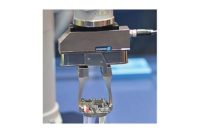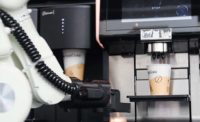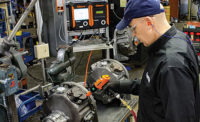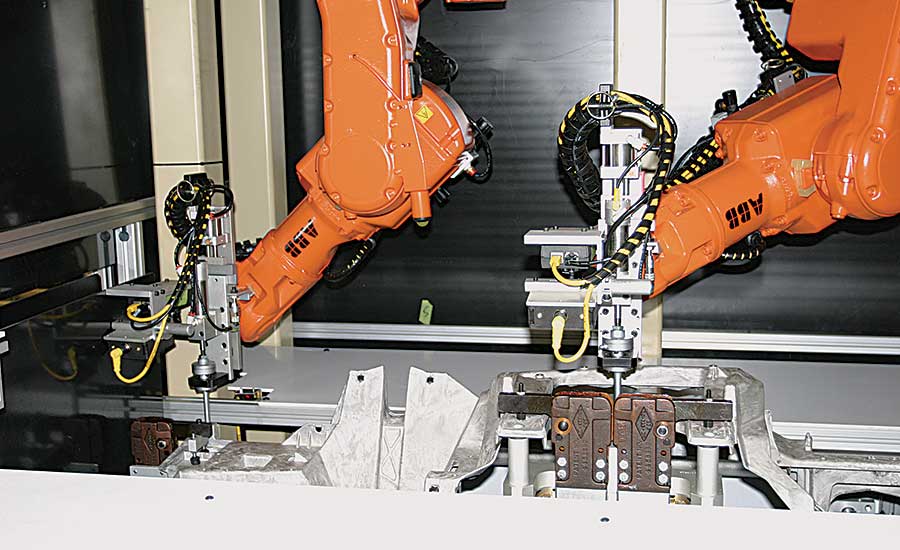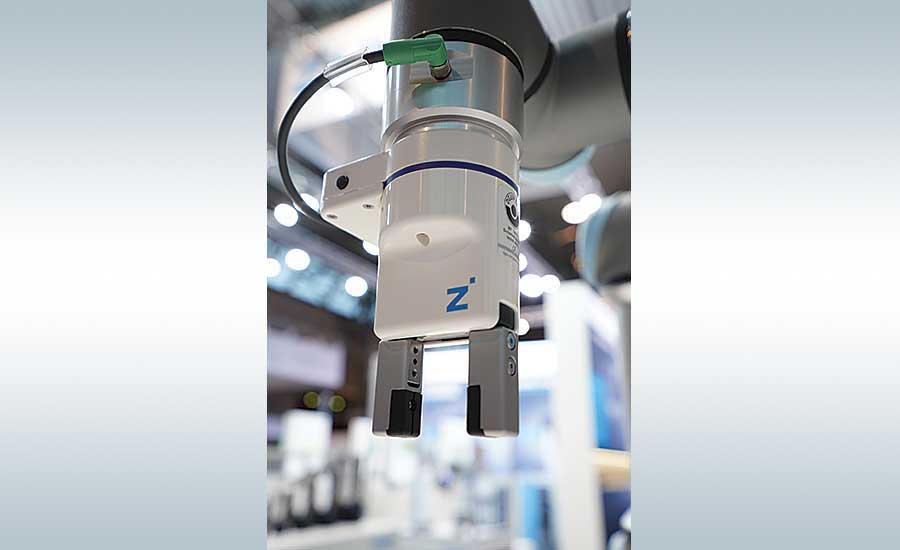What’s New With Robot End-Effectors
Equipment suppliers, and integrators, increasingly offer smart end-effectors for cobots, multi-part handling and IIOT applications






Noted horror writer Clive Barker once claimed that nothing ever truly begins or ends; rather, current things are just continuations of past things, and future things are continuations of present ones. Although interesting, this notion doesn’t work well in the world of manufacturing.
On every production line, there is definitely a beginning and end to each assembly cycle, product batch and the physical equipment that’s used to achieve both. This is especially true for robots, which feature a clearly defined arm and hand, or end-effector.
The most common and well-known type of end-effector is the finger-type gripper, whether pneumatic or electric. Close behind in popularity are vacuum grippers and cups.
Coval Vacuum Technology Inc. has been making the latter technology since the late 1980s, some for use with robots and others to be mounted on specialty housings. Allen Davis, technical sales engineer at Coval, recalls how he and his fellow engineers recently developed a specialty vacuum end-effector to help a large textile company consistently lift, move and position thin sheets of a flexible and porous material. The end-effector consisted of a high-flow air amplifier mounted on each side of a 3D-printed plastic housing.
“These amplifiers created a gripping action by pulling low-pressure vacuum flow through holes at the bottom of the housing, which was shaped like a roof section removed from a house,” explains Davis. “The sheets were small, about 200 millimeters square each, so the gripping device could easily lift one or more as needed without causing any tears.”
For many years, a powerful vacuum cup or finger gripper mounted on a large six-axis robot has been the default image many people have when they think of an end-effector. The reality is that equipment suppliers, and integrators, offer a wide variety of end of arm tooling (EOAT) for SCARA, Cartesian, delta, six-axis and collaborative robots.
Besides grippers and cups, this tooling includes clamps, tool changers, collision sensors, rotary joints, pressing units, compliance devices, deburring tools, dispense valves, fastening tools, arc welding guns and specially mounted ultrasonic welders. These end-effectors not only enable the robot to complete diverse tasks. Increasingly, they also provide data on part dimensions or on how well each end-effector is performing.
Moving Methods
Several types of EOAT are available for assembly. The impactive type refers to grippers or tooling with claws or fingers that physically grasp a part through direct impact. Astrictive tooling applies suction force to the part using vacuum, or magnetism or electroadhesion.
Ingressive tooling physically penetrates the object’s surface. It includes pins, needles and hackles, and is often used for handling textiles or carbon-fiber composites. Contigutive tooling relies on direct adhesion (surface tension, glue or freezing) to grasp a part.
There are two main ways that an end-effector effectively grips a part, according to Jesse Hayes, automation group manager at SCHUNK. The gripper fingers can be designed for form-fit (capture) gripping or force-fit (friction) gripping.
Form-fit is where you capture the part or gripped object in a positive way where grip force is not as critical to holding the part securely. With Force-fit, you are depending on the gripping force and friction between the gripper fingers and the part to hold the part securely. This option lets you change the finger martials to increase friction to have a more secure grasp on parts.
Cobots and Other Robots
Collaborative robots, or cobots, are all the rage these days among manufacturers. These robots have built-in speed and force limitation, allowing assemblers and machines to work closely without traditional safety guarding. The robots are especially effective at performing pick and place, material handling and palletizing.
“Depending on the part shape, weight and material being picked up, the cobot gripper may need to be surface-contact based, such as a vacuum cup or a magnetic gripper,” says Costas Charalambous, technical sales manager at Zimmer Group US Inc. “Alternatively, the application may require a mechanical-based system like a parallel gripper.”
Charalambous says that any gripper used on cobots must be flexible, such as parallel two-jaw, three-jaw concentric, long stroke and angular grippers. Which type is best for an application depends on factors like cycle time and if the robot needs to pick up multiple parts.
“If the cobot is machine tending, for example, and the goal is to keep it on one machine with only one part, a common setup is to have two grippers mounted at a 90-degree angle from each other,” explains Charalambous. “The finished part can be removed and the next raw part loaded with the cobot having to only move into the machine once rather than twice. Plus, the cobot can pick up the raw part and place the finished part whilst machining continues. With a single gripper, cycle time is increased because all of these tasks must be performed with the machine doors open.”
A major advantage of using an electric gripper vs. a pneumatic one is it lets the manufacturer move a cobot from station to station without being tied down by compressed air lines, as well as not needing additional air valves at each station. Electric grippers also offer programmability and have built-in sensors that can be connected directly to the cobot.
Because there are no safety fences near the cobot, its gripping force is limited to a maximum threshold guideline so as to not injure nearby workers. Charalambous notes that worker safety is further enhanced by the cobots’ smooth-edge housings and unexposed mechanical linkages that may be pinch points.
Zimmer introduced its latest cobot-specific gripper this past spring, the HRC-03. This two-jaw parallel gripper offers a maximum stroke of 10 millimeters per jaw, and it features a button that activates the robot’s free-drive mode. In this mode, the user is able to position the robot by hand instead of with the pendant controller. The gripper also features manually adjustable gripping force from 50 to 190 newtons in four stages.
According to Charalambous, the gripper directly connects to the robot’s tool I/O connector and uses the internal wiring of the robot arm. No external wiring is required. The gripper is driven by a brushless DC motor, and its safety features include a rounded shape and self-locking jaws.
“A growing area for grippers and other end-effectors are new customers who are now open to automation thanks to ease-of-use robots,” says Hayes. “Because some of these robots are also collaborative, we have new gripper designs that are certified in two ways. One is to be collaborative according to the current technical specification. The other is as an industrial plug-and-work solution that addresses ease-of-use application areas.”
Earlier this year, SCHUNK released its electric EGL-C long-stroke gripper specifically for cobots. The gripper achieves a gripping force up to 450 newtons. Stroke length is 42.5 millimeters per finger.
“Its operating software ensures that the gripper grips with a low force so a nearby worker will not be exposed to a higher force while the gripper is gripping,” says Hayes. “Plus, the EGL-C enables the cobot to safely grip heaver parts due to it being able to safely generate a higher force than the current technical specification allows.”
Coval vacuum cups are regularly used with cobots made by Universal Robots. According to Davis, one end-user equips its cobot with a custom CVGL vacuum gripper that moves bent aluminum pieces from the bending area to a bin. The gripper measures 80 by 120 millimeters and features 25 plenum cups.
Coval’s CVGC series of compact carbon vacuum grippers feature a plug-and-play design that allows for seamless integration with all cobot models. Three grippers are available, with respective dimensions of 150 millimeters square, 240 by 120 millimeters and 320 by 160 millimeters. The lightweight grippers feature a carbon fiber construction that conserves the cobot’s lifting capacity—and allows for quick assembly and disassembly without special tools.
Also beneficial is a function block that houses the vacuum generator, control cartridge, vacuum switch and silencer. Flexible peripheral foam protects the operator during tasks like palletizing and gripping boxes or plastic parts.
SCARAs can be equipped with a wide variety of end-effectors, including vacuum grippers, finger grippers, screwdrivers and soldering irons. Others mount laser displacement sensors for high-speed measurement applications, or mount plasma cutters and routers for precise etching, cutting and milling operations.
Regardless of application, when selecting an effector for a SCARA, engineers must make sure that load momentum does not exceed the motor’s ability to slow and stop arm movement.
A common application for Cartesian, or gantry robots is picking and placing parts. Cartesians can also be set up for screwdriving, dispensing, routing and cutting of material.
On a delta robot, its fourth leg can extend from the center of the hub to rotate the end-effector, which is usually a suction cup, but could also be a finger gripper. Initially, these amazingly fast robots were developed as a pick-and-place device for lightweight loads. Now, however, they are also regularly used in 3D printing and assembly operations.
“Our experience with high-speed delta robots is mostly for picking and placing of small components,” notes Christopher Clark, vice president of sales, marketing and business development at Wes-Tech Automation Solutions, an integrator since 1976. “We’ve also integrated SCARA and Cartesian robots for assembly, screw and nut driving, and to quickly move small parts. Usually, a suction cup or a magnetic-type or mechanical gripper is best for these applications.”
Jason Hitchcock, applications engineering manager at ATC Automation, says that his company regularly integrates SCARA, Cartesian and delta robots. He says that effector integration is fairly simple. All three types tend to handle small parts, and vacuum grippers usually work well in the applications. Standard EOAT can be used most of the time, including for functions like dispensing.
Integral to Success
Equipment suppliers primarily offer standard end-effectors, whereas integrators primarily develop custom EOAT. Clark says nearly 90 percent of the end-effectors that Wes-Tech develops are custom.
“Having the right end-effector is probably the most critical factor in building a successful assembly system,” says Clark. “Properly and efficiently moving parts is the key to any working application, so an improperly designed end-effector can sink the project very quickly.”
Multifunctional effectors are Wes-Tech’s specialty, as the integrator views each effector as an important processing tool. Clark points out that Wes-Tech’s 50-engineer staff has developed individual effectors that perform ultrasonic welding and part handling, or adhesive dispensing and part handling.
“Increasingly, manufacturers want their assembly system grippers to handle more than one SKU,” says Dave Goodenough, director of the robot technology department at Edgewater Automation. “They also want their vacuum systems to pick more than one part at different times or at the same time.”
For Tesla Inc. in Fremont, CA, Wes-Tech developed custom EOAT in 2017 with special features to handle brackets, plates and assemblies processing equipment. This tooling enables the manufacturer to perform ultrasonic welding on painted front and rear fascias without any of the weld bleeding through.
A different automotive OEM had Wes-Tech build an end-effector with a mounted vision system. This system inspects holes on the bottom of each vehicle chassis to make sure all of them are clear. Another robot then inserts plugs in select holes, before workers insert electrical cabling or hoses in the remaining holes. According to Clark, special brackets on the effector ensure excellent camera access to the bottom of the chassis without colliding into it.
A robot’s payload capacity and the end-effector sensors often present challenges during integration, claims Hitchcock. Part and effector weight must be carefully determined so as to not exceed capacity and force the end-user to install a larger robot.
“The real challenge regarding end-effector sensors is making sure that all of a robot’s motion doesn’t compromise the sensor in any way,” says Hitchcock. “This situation can prevent key function information and data from getting sent back to the robot’s control system.”
Hitchcock says that ATC often mounts a hub on the side of an end-effector to ensure that all data gets back to the control system. Up to eight cables can be connected to the hub, from which a single cable connects to the control system.
“Obtaining helpful data is the reason for Industry 4.0, and for the end-effector this may include cycle count, hours in operation, part size and force needed to lift it,” notes Hitchcock. “This data is not free, though, so sometimes the end-user tells us that ‘it would be nice to have the data, but it’s not important enough to pay for.’”
Magnets, Needles and Forks
Several suppliers offer EOAT to help manufacturers grip and move parts in more specialized applications. For example, the Compact series of magnetic grippers from Compact Automation are effective at picking up ferromagnetic materials such as iron or steel in applications where other types of grippers and vacuum cups are currently being used. The four models in the series offer grip forces of 20 to 130 pounds, and safely hold the materials even with the loss of pneumatic pressure.
Needle grippers feature inclined and intersecting needles that provide reliable gripping of textiles, fiber composites and highly porous materials. The OPT 34-25 pneumatic needle gripper from Applied Robotics Inc. offers a short cycle time for high-speed applications, a robust housing suitable for heavy applications, high repeatability and long service life. Unit weight is only 1.65 pounds, yet the gripper has a payload capacity of 3.2 pounds. Gripper repeatability is ±0.002 inch.
SAS Automation makes custom retracting fork-style EOAT that is well suited for open-top containers and oversized bags that must be picked from the bottom. When extended, the forks efficiently pick a large product off a roller conveyor and move it where required, usually to a pallet. The forks are then retracted through a stationary stripper plate and the product is placed on the pallet.
Looking for a reprint of this article?
From high-res PDFs to custom plaques, order your copy today!




